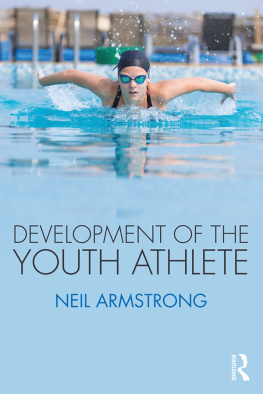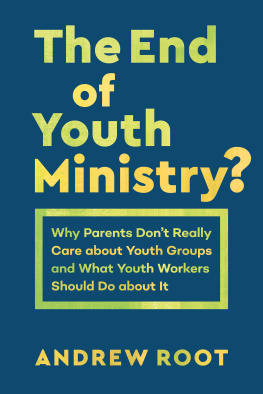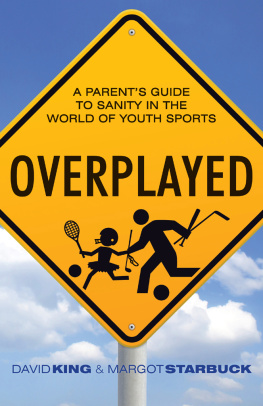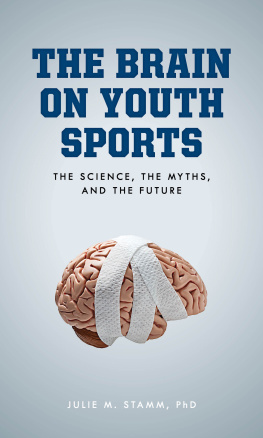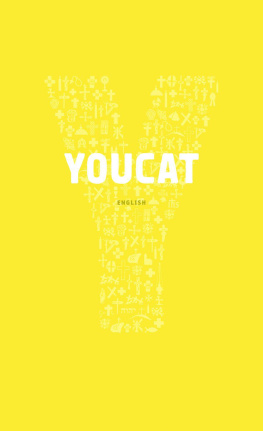
YOUTH SPORT AND SPIRITUALITY

CATHOLIC PERSPECTIVES

edited by
PATRICK KELLY, SJ
University of Notre Dame Press Notre Dame, Indiana
University of Notre Dame Press
Notre Dame, Indiana 46556
undpress.nd.edu
All Rights Reserved
Copyright 2015 by the University of Notre Dame
Published in the United States of America
Library of Congress Cataloging-in-Publication Data
Youth sport and spirituality : Catholic perspectives / edited by Patrick Kelly, SJ.
pages cm
Includes bibliographical references and index.
ISBN 978-0-268-01235-9 (pbk. : alk. paper)
ISBN 0-268-01235-0 (pbk. : alk. paper)
1. SportsReligious aspectsCatholic Church.
2. AthletesReligious life.
3. SportsPsychological aspects.
4. SportsSociological aspects.
I. Kelly, Patrick M. (Patrick Michael), 1960 editor.
GV706.42.Y68 2015
796.01'9dc23
2015023724
ISBN 9780268024017
The paper in this book meets the guidelines for permanence and durability of the Committee on Production Guidelines for Book Longevity of the Council on Library Resources.
This e-Book was converted from the original source file by a third-party vendor. Readers who notice any formatting, textual, or readability issues are encouraged to contact the publisher at .
Jesus said, Let the children come to me and do not prevent them.
Matthew 19:14 (NABRV)
CONTENTS
Patrick Kelly, SJ
PART 1
RESEARCH-BASED AND THEORETICAL PERSPECTIVES
Daniel A. Dombrowski
Patrick Kelly, SJ
Nicole M. LaVoi
Mike McNamee
Clark Power
David Light Shields and Brenda Light Bredemeier
Patrick Kelly, SJ
Richard R. Gaillardetz
PART 2
PRACTICES AND PERSPECTIVES
Kristin Komyatte Sheehan
Dobie Moser
Jim Yerkovich
Sherri Retif
James Charles Naggi
Nicole M. LaVoi
Edward Hastings
Patrick Kelly, SJ
PATRICK KELLY, SJ
Youth Sport and Spirituality: Catholic Perspectives is a unique book that meets a pressing need at this time. The book is unique because it is the first of its kind that brings resources from Catholic cultural and intellectual traditions into meaningful conversation with scholarship on youth sport to address problems and opportunities in this domain of young peoples lives. The first two chapters consider the question What is sport? and provide an overview of the history of Catholic engagement with play and sport. The remaining chapters are about how experiences of participation in youth sport can foster the integral development of the young person, and his or her search for meaning in life from a Christian perspective.
The book is divided into two sections. The first section contains chapters written by scholars from different academic disciplines. These chapters, while based on sound research and scholarship, are written without academic jargon or extensive footnotes. The second section of the book contains chapters written by coaches and other practitioners who work closely with young people in sport on a day-to-day basis.
The primary audience for Youth Sport and Spirituality is youth coaches, physical education teachers, and athletic directors who work in Catholic school and parish settings. The book will also be of interest to other groups, including youth ministers, Catholic educators and administrators, parish priests and staffs, Catholic parents of children involved in sports, university students who are preparing to teach or coach in Catholic schools, Christians of other denominations, and anyone interested in the relationship between youth sport (or sport in general) and spirituality. Academics from the disciplines represented in the book, namely, philosophy, moral development, education, psychology, theology, and spirituality, will also find resources that are of interest to them. Catholic theologians and scholars of spirituality, in particular, will find that the book treats an area of human experience that has been woefully neglected in their disciplines.
Indeed, Catholic theologians and scholars of spirituality have not paid much attention to sport in the modern world. This is curious, given the Catholic sacramental worldview and emphasis on finding God in all things, and the Catholic tendency to accept diverse cultural experiences and customs and to incorporate these into the life and even the worship of the church. The lack of attention paid to sport is even more surprising, given that sport is a human universal, that is, it has been a part (in one form or another) of all cultures for which we have recorded histories. Sport is also pervasive in U.S. culture in our own time and in educational institutions, as well as in Catholic schools and parish settings themselves. It embodies many of the values and disvalues of the culture of the United States and plays an enormously influential role in the formation of young people. For these reasons, it is important that Catholic theologians and scholars of spirituality begin to pay attention to sport in our time.
Since this book is about youth sport and spirituality, it is important to say something about what spirituality is. Many scholars of spirituality today are trying to find a way to think about spirituality that doesnt limit it to persons who belong to a particular religious tradition. David Perrin is one scholar who has written about what this might mean. For Perrin, spirituality is a fundamental capacity in human beings. One of the first things he mentions in this regard is the human capacity for self-transcendence. As he puts it,
Spirituality, as an innate human characteristic, involves the capacity for self-transcendence: being meaningfully involved in, and personally committed to, the world beyond an individuals personal boundaries. This meaningful involvement and commitment shapes the way people live and allows them to integrate their lives.1
For Perrin, spirituality in this sense can be expressed in human experience before a person identifies with a particular religious or spiritual tradition or beliefs, rituals, or ethics.
For Perrin, spirituality also has to do with the big questions that all human beings ask. We try to forge meaning and find purpose and hope in the midst of our life experiences, which at times can seem disconnected or random. We attempt to make sense of it all. And we do so in the context of what is ultimately important to us. As he puts it, Spirituality stands at the junction where the deepest concerns of humanity, and the belief in transcendent values, come together in the movement toward ultimate fulfillment in life.2
The strength of this broad rendering of spirituality lies in its inclusiveness. It could refer to spirituality in any religious tradition. It doesnt require belief in God and so could be used with reference to nontheistic traditions such as one finds in some expressions of Buddhism. Or it could account for a spirituality that exists outside of organized religion, such as twelve-step spirituality. It is important to note that for Perrin, spirituality has to do with a way of life. His use of the word integrate signals that spirituality has to do with the way a person brings together all of the dimensions of his or her life into a meaningful whole.
Next page


